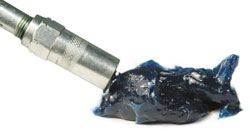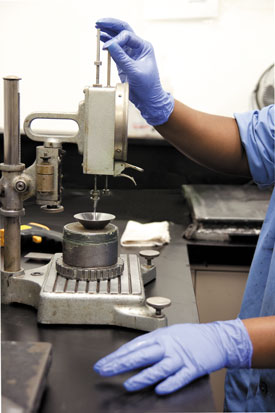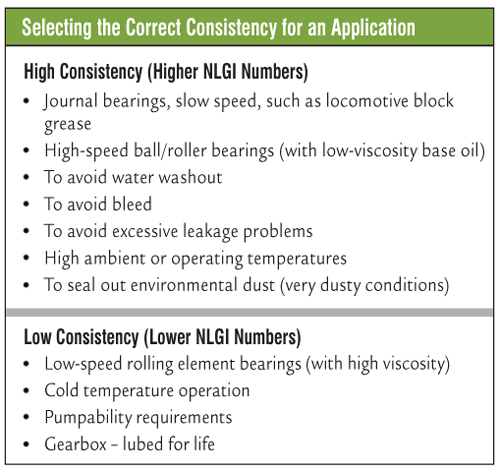When instructing Noria’s Fundamentals of Machinery Lubrication course, I usually ask my students to tell me the type of grease that they currently use at their facility and not to give me a color. Most technicians understand that color doesn’t reveal much about a grease’s properties, but they don’t always answer correctly with the base oil viscosity, thickener and consistency.

Of course, greases are formulated with oil, thickener and additives. While you may be familiar with the formulation of grease, do you know what grease consistency means and how it should influence your grease selection?
Base Oil
Grease is formulated with up to 95 percent base oil. Most greases today use mineral oil as their fluid components. These mineral oil-based greases typically provide satisfactory performance in most industrial applications. In temperature extremes (low or high), a grease that utilizes a synthetic base oil will offer better stability.
Thickener
The thickener is a material that will produce the solid to semifluid structure in combination with the selected lubricant. The primary types of thickeners used in grease are metallic soaps. These soaps include lithium, aluminum, clay, sodium and calcium. Lately, complex thickener-type greases are gaining popularity. They are being selected because of their high dropping points and excellent load-carrying abilities.
Complex greases are made by combining the conventional metallic soap with a complexing agent. The most widely used complex grease is lithium-based. These greases are made with a combination of conventional lithium soap and a low-molecular-weight organic acid as the complexing agent.
Nonsoap thickeners are also gaining in popularity for special applications, including high-temperature environments. Bentonite and silica aerogel are two examples of thickeners that do not melt at high temperatures. However, there is a misconception that even though the thickener may be able to withstand the high temperatures, the base oil will oxidize quickly at elevated temperatures, thus requiring a frequent relube interval.
Notice in the table below how much the thickener percentage affects grease consistency. Keep in mind that there is a substantial amount of oil in the grease and that field conditions can also influence grease consistency.

Cone Penetrometer
Consistency
Grease consistency depends on the type and amount of thickener used along with the viscosity of its base oil. A grease’s consistency is its ability to resist deformation by an applied force. The measure of consistency is called penetration, which is contingent on whether the consistency has been altered by handling or working.
ASTM D217 and D1403 methods are used to determine the penetration of unworked and worked greases. To measure penetration, a cone of a specific weight is allowed to sink into a grease for five seconds at a standard temperature of 25 degrees C (77 degrees F). The depth, in tenths of a millimeter, to which the cone sinks into the grease is its penetration.
A penetration of 100 would represent a solid grease, while a penetration of 450 would be semifluid. The National Lubricating Grease Institute (NLGI) has established consistency numbers or grade numbers from 000 to 6 that correspond to specified ranges of penetration numbers.
Certain conditions will affect the consistency required for a grease. The table below can help you select the correct consistency for an application.
5 Categories of Penetration
Undisturbed - Grease that is in its original container.
Unworked - A sample that has received only minimal disturbance in being transferred from the sample can to the test cup.
Worked - A grease that has been subjected to 60 double strokes in a standard grease worker. NLGI classification is based on worked penetration.
Prolonged Worked - Grease that has been worked the specified number of strokes (more than 60), brought back to 77 degrees F and then subjected to an additional 60 double strokes in the grease worker.
Block - This is the penetration of a block grease, which is hard enough to hold its shape without a container.Additives
Additives can play several roles in a lubricating grease. These primarily include enhancing the existing desirable properties, suppressing the existing undesirable properties and imparting new properties. The most common additives are oxidation and rust inhibitors, extreme pressure, anti-wear and friction-reducing agents.
In addition to these additives, boundary lubricants such as molybdenum disulfide (moly) or graphite may be suspended in grease to reduce friction and wear without adverse chemical reactions to the metal surfaces during heavy loading and slow speeds.

It’s important to note that speed and load help determine the proper viscosity required for an application. Remember, viscosity is the most important property of a lubricant. Whenever you are selecting grease, you must also take into consideration the application and match the required consistency to ensure that you provide the equipment with the best choice to improve equipment reliability.


.jpeg)

